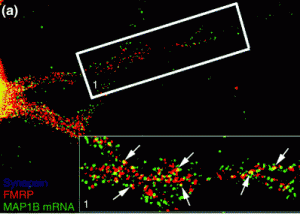
Kristen Thomas, PhD, now a postdoctoral fellow at St Jude Children’s Research Hospital
Schizophrenia genetics and its complexities are beginning to yield to large genome-wide studies. One of the recently identified top risk loci, miR 137, can be seen as a master key that unlocks other doors. The Mir 137 locus encodes a micro RNA that regulated hundreds of other genes, and several of those are also linked to schizophrenia.
Earlier this month, Emory’s chair of cell biology Gary Bassell and former graduate student Kristen Thomas published a paper in Cell Reports analyzing how perturbing Mir 137 affects signaling in neurons. Inhibiting Mir 137 blocked neurons’ responses to neuregulin and BDNF, well-known growth factors.
“We think a particularly interesting aspect of our paper is that it links miR137, neuregulin and ErbB4 receptor: three molecules with known genetic risk for schizophrenia,” Bassell writes. Read more







